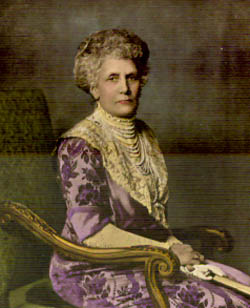 |
 |
 |
 |
 |
 |
 |
 |
 |
Mary IV and III
On December 15, 1849, when Mary Theresa was only five months old, her father Archduke Ferdinand died from typhus. Mary Theresa was therefore raised by her mother Archduchess Elisabeth. On April 18, 1854, Archduchess Elisabeth married Archduke Karl Ferdinand of Austria, Duke of Teschen, by whom she had six children (half brothers and sisters to Mary Theresa): Archduke Franz, Archduke Friedrich, Archduchess Maria Christina (later Queen of Spain), Archduke Karl Stephan, Archduke Eugen, and Archduchess Eleonore. Through her mother, Mary Theresa was also first cousin to Stephanie, Crown Princess Rudolf of Austria-Hungary; Clementine, Princess Napoleon; and Maria Dorothea, Duchess of Orleans. On February 20, 1868, in the Augustinerkirche in Vienna, Mary Theresa married Prince (later King) Ludwig of Bavaria, eldest son of Prince Regent Luitpold. The chief witness of the marriage was the Bishop of Brno, Count Antonius Schaffgotsch, who had previously baptised, confirmed, and given first communion to Mary Theresa. Ludwig was nephew to Queen Adelgunde and King Francis I (Queen Adelgunde was the sister of Prince Regent Luitpold). Ludwig and Mary Theresa had thirteen children:
At the death of her uncle Francis, November 20, 1875, Mary Theresa succeeded to all of his British rights. She was henceforward recognised by the Jacobites as "Queen Mary IV and III". Mary Theresa is called "Queen Mary III" by those Jacobites who do not number Mary Stuart as Mary II of England. The majority of Mary Theresa's married life was spent raising her children. Although her husband Ludwig was second in line to the throne of Bavaria, they lived a relatively humble existence. When not attending to official duties, Mary Theresa and her family lived mostly on their huge farming estate at Leutstetten (some thirty kilometres south of Munich); it was here that Mary Theresa had her famous rose gardens. On January 10, 1865, Mary Theresa was named a Dame of the (Austrian) Order of the Starry Cross. From October 19, 1872 she was Grand Mistress of the (Bavarian) Order of Theresia and of the (Bavarian) Order of Saint Elisabeth. She was also a Dame of the (Spanish) Order of Maria Luisa, and was awarded the (Austrian) Order of Elisabeth 1st Class, the Order of Merit of the Bavarian Crown, the Cross of Merit for the Year 1870/71, the Cross of Merit for Voluntary Nursing, and the (Prussian) Red Cross Medal 2nd Class. She spoke German, Hungarian, Czech, French, and Italian. On November 5, 1913, Mary Theresa's husband, Ludwig, had himself proclaimed King of Bavaria in succession to his mad (but still living) cousin, King Otto I. From this time forward Mary Theresa used the title "Queen of Bavaria". Ludwig's brief reign was marred by the advent of the First World War; Mary Theresa spent these years preparing care packages for soldiers. King Ludwig was forced to abdicate the throne of Bavaria, November 7, 1918. Mary Theresa and her family left Munich in order to escape from the Bolshevik revolutionaries. They took refuge at Schloss Wildenwart near the town of Frasdorf. Mary Theresa died at Schloss Wildenwart, February 3, 1919, when she was succeeded in her British rights by her eldest son Rupert. On February 6, 1919, her remains were laid in the chapel at Schloss Wildenwart; on November 5, 1921 they were transferred (together with those of her husband) to the cathedral (Liebfrauendom) of Munich.
This page is maintained by Noel S. McFerran (noel.mcferran@rogers.com) and was last updated
July 23, 2007. |
